Alterations in Plasma microRNA and Protein Levels in War Veterans with Chronic Mild Traumatic Brain Injury
- PMID: 32024417
- PMCID: PMC7249467
- DOI: 10.1089/neu.2019.6826
Alterations in Plasma microRNA and Protein Levels in War Veterans with Chronic Mild Traumatic Brain Injury
Abstract
Blast-related mild traumatic brain injury (mTBI) is considered the "signature" injury of the wars in Iraq and Afghanistan. Identifying biomarkers that could aid in diagnosis and assessment of chronic mTBI are urgently needed, as little progress has been made toward identifying blood-based biomarkers of repetitive mTBI in the chronic state. Addressing this knowledge gap is especially important in the population of military veterans who are receiving assessment and care often years after their last exposure. Circulating microRNAs (miRNAs), especially those encapsulated in extracellular vesicles (EVs), have gained interest as a source of biomarkers for neurological conditions. To identify biomarkers for chronic mTBI, we used next generation sequencing (NGS) to analyze miRNAs in plasma and plasma-derived EVs from 27 Iraq and Afghanistan war veterans with blast-related chronic mTBI, 11 deployed veteran non-TBI controls, and 31 civilian controls. We identified 32 miRNAs in plasma and 45 miRNAs in EVs that significantly changed in the chronic mTBI cohort compared with control groups. These miRNAs were predominantly associated with pathways involved in neuronal function, vascular remodeling, blood-brain barrier integrity, and neuroinflammation. In addition, the plasma proteome was analyzed and showed that the concentrations of C-reactive protein (CRP) and membrane metalloendopeptidase (MME) were elevated in chronic mTBI samples. These plasma miRNAs and proteins could potentially be used as biomarkers and provide insights into the molecular processes associated with the long-term health outcomes associated with blast-related chronic mTBI.
Keywords: EVs; biomarkers; mTBI; miRNAs; veterans.
Conflict of interest statement
No competing financial interests exist.
Figures





Similar articles
-
The role of biomarkers and MEG-based imaging markers in the diagnosis of post-traumatic stress disorder and blast-induced mild traumatic brain injury.Psychoneuroendocrinology. 2016 Jan;63:398-409. doi: 10.1016/j.psyneuen.2015.02.008. Epub 2015 Feb 23. Psychoneuroendocrinology. 2016. PMID: 25769625
-
Postconcussion symptoms reported by Operation Enduring Freedom/Operation Iraqi Freedom veterans with and without blast exposure, mild traumatic brain injury, and posttraumatic stress disorder.J Clin Exp Neuropsychol. 2017 Jun;39(5):449-458. doi: 10.1080/13803395.2016.1232699. Epub 2016 Sep 28. J Clin Exp Neuropsychol. 2017. PMID: 27681407
-
White matter abnormalities are associated with overall cognitive status in blast-related mTBI.Brain Imaging Behav. 2017 Aug;11(4):1129-1138. doi: 10.1007/s11682-016-9593-7. Brain Imaging Behav. 2017. PMID: 27704406 Free PMC article.
-
Complicating factors associated with mild traumatic brain injury: impact on pain and posttraumatic stress disorder treatment.J Clin Psychol Med Settings. 2011 Jun;18(2):145-54. doi: 10.1007/s10880-011-9239-2. J Clin Psychol Med Settings. 2011. PMID: 21626354 Review.
-
Blast-Related Mild Traumatic Brain Injury: Neuropsychological Evaluation and Findings.In: Kobeissy FH, editor. Brain Neurotrauma: Molecular, Neuropsychological, and Rehabilitation Aspects. Boca Raton (FL): CRC Press/Taylor & Francis; 2015. Chapter 32. In: Kobeissy FH, editor. Brain Neurotrauma: Molecular, Neuropsychological, and Rehabilitation Aspects. Boca Raton (FL): CRC Press/Taylor & Francis; 2015. Chapter 32. PMID: 26269927 Free Books & Documents. Review.
Cited by
-
The evolving role of extracellular vesicles (exosomes) as biomarkers in traumatic brain injury: Clinical perspectives and therapeutic implications.Front Aging Neurosci. 2022 Oct 6;14:933434. doi: 10.3389/fnagi.2022.933434. eCollection 2022. Front Aging Neurosci. 2022. PMID: 36275010 Free PMC article. Review.
-
Blood-Based Biomarkers in the Diagnosis of Chronic Traumatic Encephalopathy: Research to Date and Future Directions.Int J Mol Sci. 2023 Aug 8;24(16):12556. doi: 10.3390/ijms241612556. Int J Mol Sci. 2023. PMID: 37628736 Free PMC article. Review.
-
Cerebrospinal Fluid MicroRNA Changes in Cognitively Normal Veterans With a History of Deployment-Associated Mild Traumatic Brain Injury.Front Neurosci. 2021 Sep 9;15:720778. doi: 10.3389/fnins.2021.720778. eCollection 2021. Front Neurosci. 2021. PMID: 34580583 Free PMC article.
-
The biological significance and clinical utility of emerging blood biomarkers for traumatic brain injury.Neurosci Biobehav Rev. 2021 Nov;130:433-447. doi: 10.1016/j.neubiorev.2021.08.029. Epub 2021 Aug 30. Neurosci Biobehav Rev. 2021. PMID: 34474049 Free PMC article. Review.
-
Fluid biomarkers of chronic traumatic brain injury.Nat Rev Neurol. 2024 Nov;20(11):671-684. doi: 10.1038/s41582-024-01024-z. Epub 2024 Oct 3. Nat Rev Neurol. 2024. PMID: 39363129 Review.
References
-
- Defense and Veterans Brain Injury Center (2016). DoD Worldwide Numbers for TBI. DVBIC Available from: http://dvbic.dcoe.mil/dod-worldwide-numbers-tbi (Last accessed April20, 2018)
-
- Cernak I., Ignjatović D., Andelić G., and Savić J. (1991). Metabolic changes as part of the general response of the body to the effect of blast waves [in Serbian]. Vojnosanit. Pregl. 48, 515–522 - PubMed
-
- Petrie E.C., Cross D.J., Yarnykh V.L., Richards T., Martin N.M., Pagulayan K., Hoff D., Hart K., Mayer C., Tarabochia M., Raskind M.A., Minoshima S., and Peskind E.R. (2014). Neuroimaging, behavioral, and psychological sequelae of repetitive combined blast/impact mild traumatic brain injury in Iraq and Afghanistan war veterans. J. Neurotrauma 31, 425–436 - PMC - PubMed
Publication types
MeSH terms
Substances
Grants and funding
LinkOut - more resources
Full Text Sources
Medical
Research Materials
Miscellaneous

